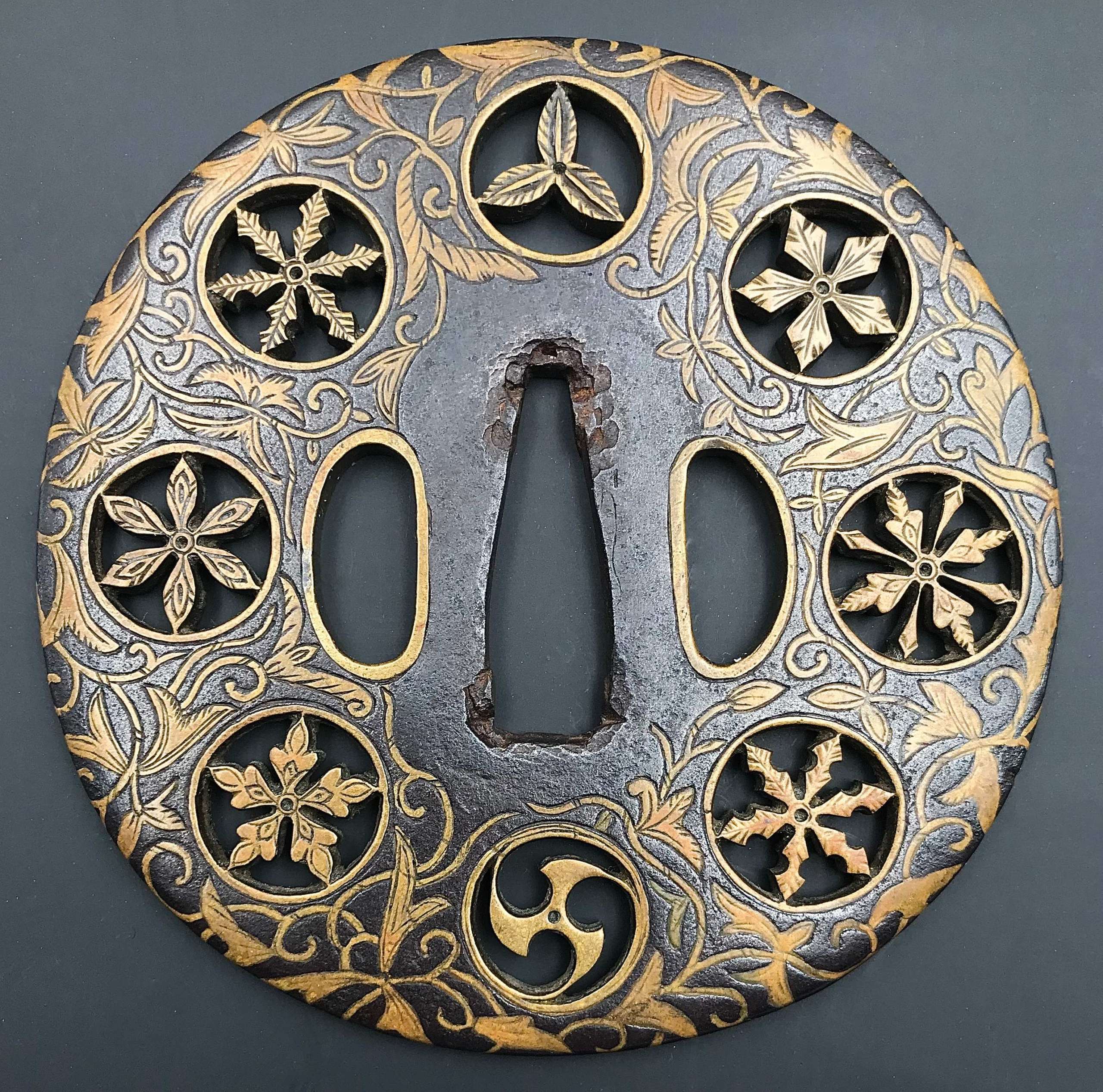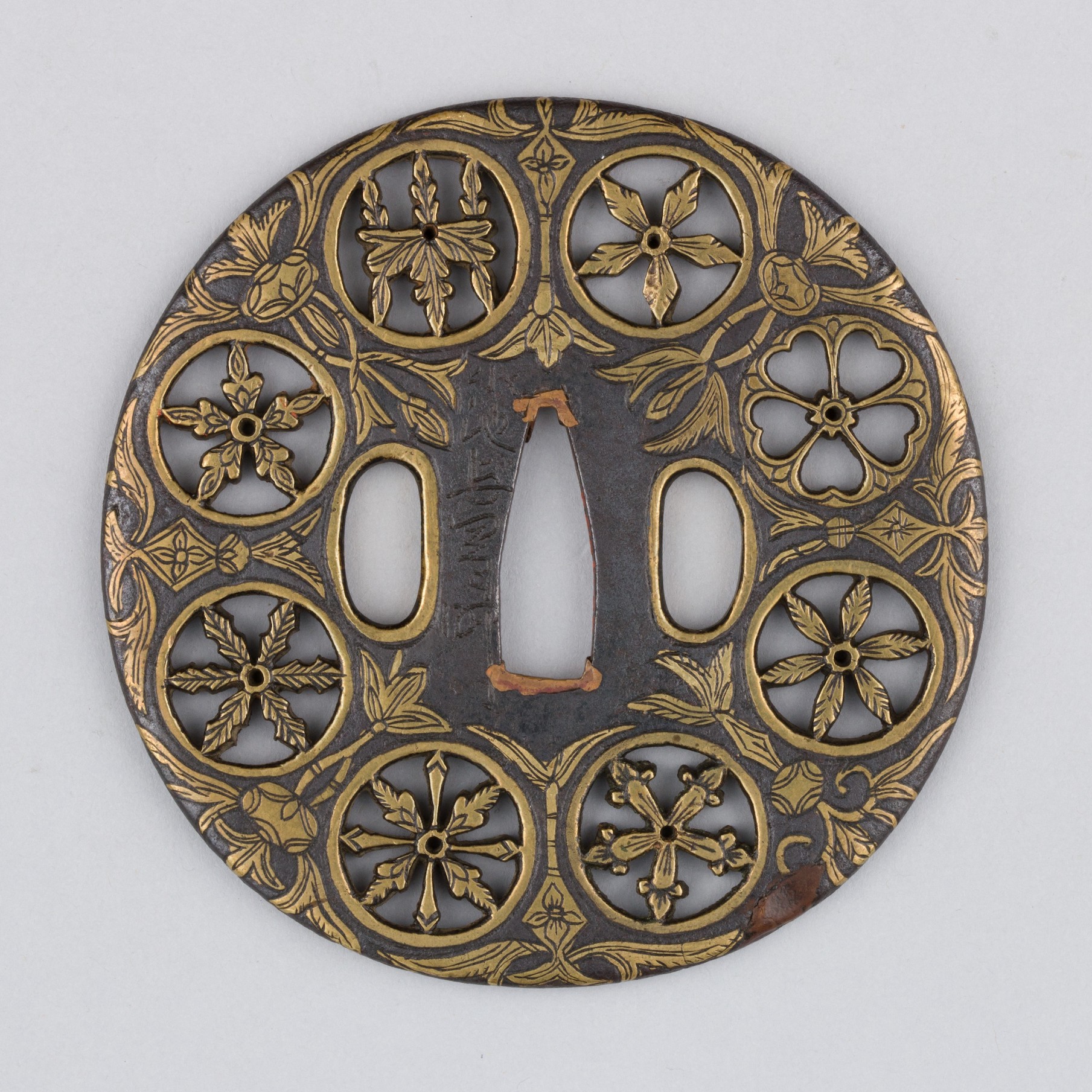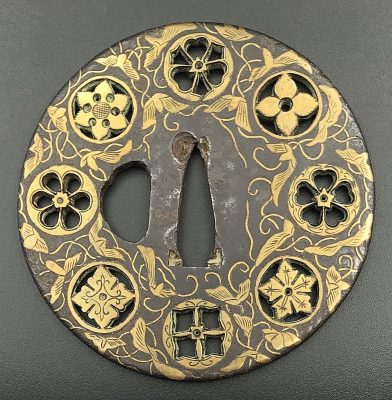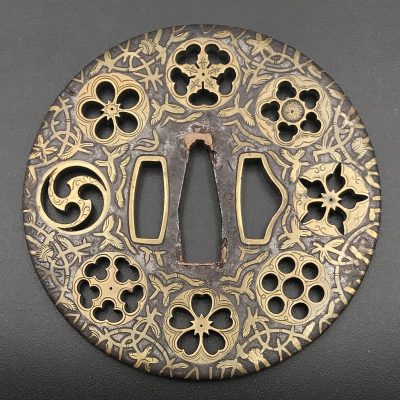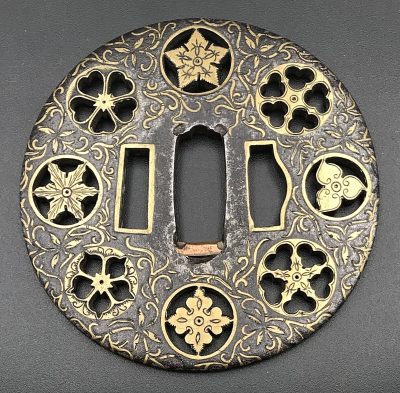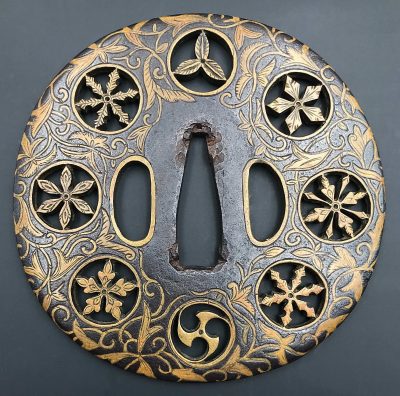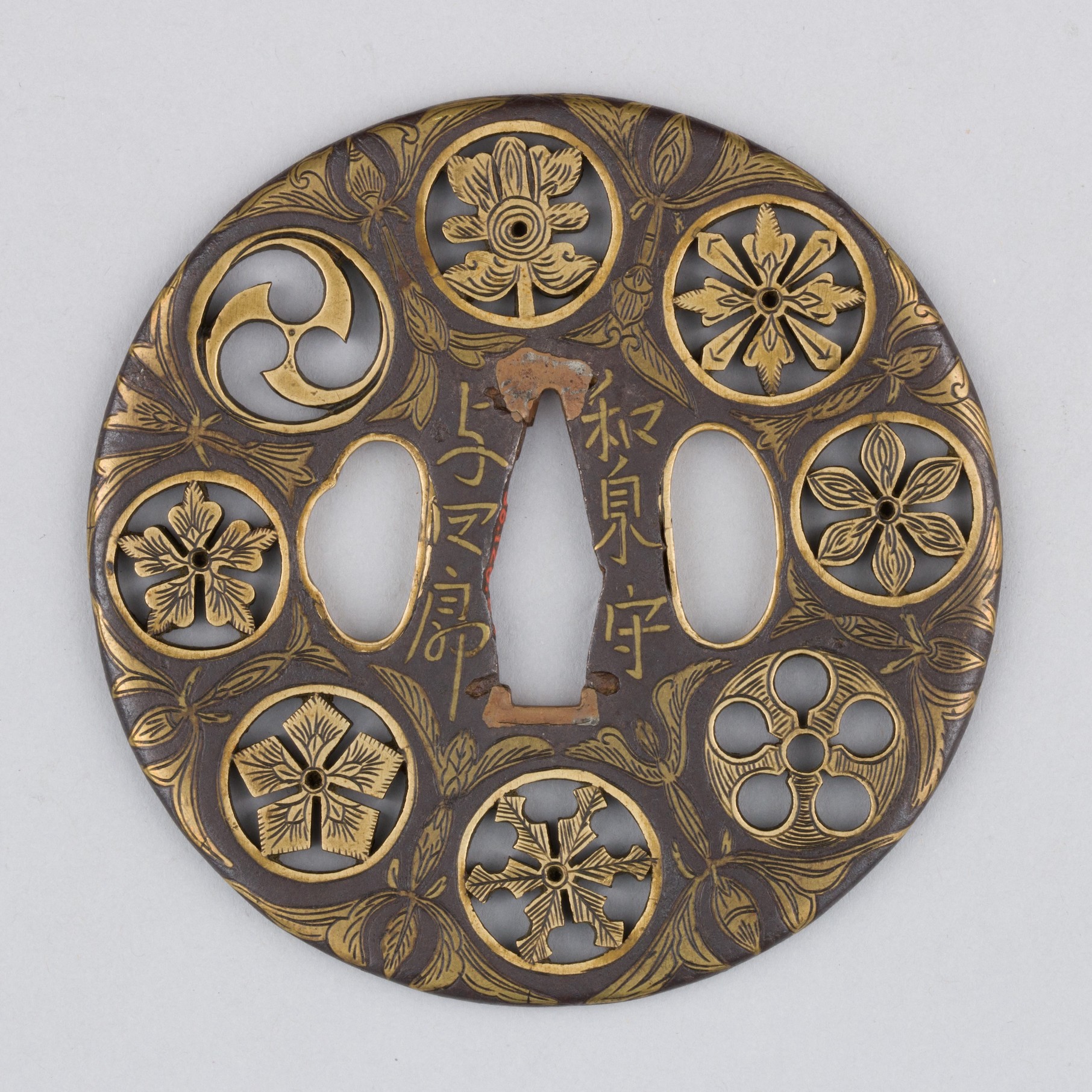Introduction.
During past 100 years the term ‘Yoshirō tsuba‘ was used so many times describing so many different kinds of the Japanese sword guard, that I endeavored to write a short overview in an attempt to clarify the matter. The latest source of information about Yoshirō tsuba happened to be the Gary D. Murtha’s book “Japanese Sword Guards. Onin-Heianjo-Yoshiro”, self-published in 2016 [1]. Here the author shows how “Heianjō Mogusa Tsuba” has transformed into Heianjō Mon Tsuba”, and then into “Yoshorō Tsuba”.
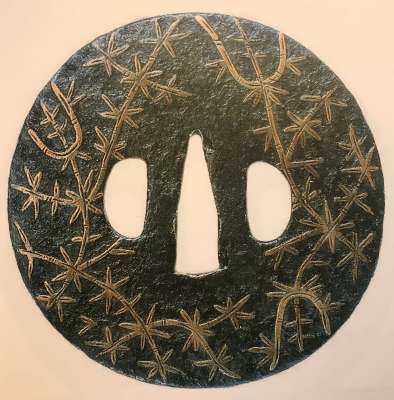 Fig. 1. Heianjō Mogusa Tsuba. Gary D. Murtha. |
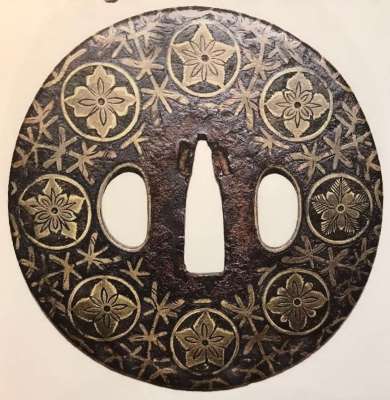 Fig. 2. Heianjō Mon Tsuba. Gary D. Murtha. |
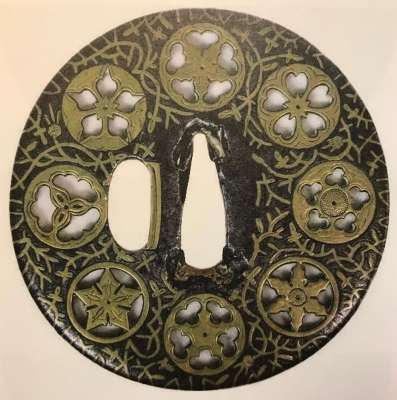 Fig. 3. Yoshirō Tsuba. Gary D. Murtha. |
At the beginning of the ‘Yoshirō tsuba’ chapter, Mr. Murtha cites “Tsuba. An aesthetic study” [2] by Kazutaro Torigoye and Robert E. Haynes, and then he adds a few more details drawn from an unspecified source: “Other Kaga Yoshiro artists are Masaie and Koike Kinchiro Naomasa. He continues: “The original Bizen Yoshiro artist is called Saburodayu because his name is not known.” The latter passage is probably a paraphrase of Torigoye’s “There is one other artist whose work closely resembles that of Koike Yoshirō. He is called Saburodayu, or the school of Saburodayu, for the individual artist is not known.”
From Mr. Murtha’s book we can conclude that there was an artist in Kyōto who bore the name of Koike Yoshirō Naomasa, who later moved to Kaga Province, and that in Kaga there was someone Saburodayu who learned the technique from Naomasa, and then moved to Bizen Province. These statement comply with the story presented by Torigoye and Haynes. “Tsuba. An aesthetic study” had been written in 1963 and reprinted many times since then. Most information in it is based on the Torigoye’s book “Tsuba Geijitsu Kō”, written in around 1962. It is unlikely that later prints of the book accommodated any new data regarding Yoshirō tsuba. Twenty years after the first publication of “An Aesthetic Study” Robert E. Haynes repeated the description of Yoshirō tsuba in his Catalog #5 almost word to word [3]:
“Kaga Yoshirō and Bizen Yoshirō tsuba:
In former times at Edo, Shinchū-zōgan tsuba were called Yoshirō tsuba. In Edo this name applied to all brass inlaid tsuba with floral designs. Of course, Yoshirō tsuba originate from the Heianjō-zōgan school and are not of independent origin. They represent one derivative style of the later Heianjō-zōgan tsuba. The term Yoshirō is but part of the name of Koike Yoshirō Naomasa. He is said to have been a native of Kyōto and later to have moved to the province of Kaga. Naomasa worked about the Kanchō era [probably – Keicho] (1596-1614), or Genna (1615-1623). […] His early work, while he was in Kyōto, has usual floral brass inlay, but none of the openwork brass inlays to be found in his later Kaga style. It has been said that there were no brass inlaid tsuba made in Kaga before Yoshirō moved there. If we accept this theory then it would be logical to suppose that it was his style that was to predominate in Kaga in later times but this is not the case. The Kaga inlay style, native to the province, was far different from that used by Koike Yoshirō, and it would seem that after his period his style was no longer plasticized in Kaga. The native Kaga inlay style was in parallel production to that of Yoshirō. It’s origin will be found in a different school of inlay”.
Saburodayu tsuba:
There is one other artist whose work closely resembles that of Koike Yoshirō. He is called Saburodayu, or the school of Saburodayu, for the individual artist is not known. It would seem that this artists originated in the province of Kaga and later went to Bizen Province. He there introduced the Kaga style to the artists of Bizen this creating the Bizen Yoshirō style. He worked about the Shōō era (1652-1654). His style is about midway between that of Kaga Yoshirō and the later Bizen Yoshirō. It cannot be stated with any certainty why he moved to Bizen or when the move was made.
Bizen Yoshirō tsuba:
The Bizen Yoshirō school does not seem to have existed before Saburodayu arrived. So we must conclude that he was the originator, or at least the purveyor, of Kaga Yoshirō style. The major difference between the two school should be noted:
- Bizen Yoshirō tsuba are younger than those of Kaga by several decades [SV: if the age is not indicated on tsuba then this symptom does not help].
- The tsuba made in Bizen may have shakudō and/or gold in addition to the brass inlay, or may not have brass inlay at all [SV: If we see no brass inlay, or if we see the shakudō or gold inlay, then we know it’s a Bizen school tsuba; but if it is just brass inlay then we cannot not tell whether it is a Kaga tsuba or a Bizen tsuba.]
- The signed work of Bizen is more detailed than that of the unsigned Kaga work, which seems rough and broad by comparison. [SV: If both are unsigned or both signed, then what? Also, ‘rough and broad’ is an arbitrary characteristic].
It is clear that there were two generations who used the name Bizen Yoshirō. The first generation worked about Kambun era (1661-1672). The second generation worked about the Genroku era (1688-1703). […] In the work of the first Bizen Yoshirō we see large hitsu-ana of undulating cloud forms. This would seem the sole characteristic separating his work from the other Bizen artists. In rare cases small nanako dots, or gold and silver ten-zōgan are to be found. Sometime after the middle of the Edo age the work of the Bizen Yoshirō school disappears, and there is no later work in the style of this school. The signatures found on tsuba are the following: Yoshirō saku, or Yoshirō kore (wo) tsukuru, this is the signature of the first Bizen Yoshirō. Other signatures are Umon Nagatsugu, or Koike Umon Nagatsugu, with Okayama jū nin on the back. Also Bizen Yoshirō Nagatsugu saku. Umon Nagatsugu and Koike Nagatsugu are the same person.
Footnotes: … I have studied the samurai records of the clans of Kaga of this period. I can find no entry of the name Koike Yoshirō. From this I must conclude that he worked as a private smith in Kaga and did not receive payment for his services as a vassal to the lord of the province. Robert Haynes reports a signature Genroku Jūnen Hatchigatsu Kichinichi Bizen Yoshirō Nagatsugu kore (wo) tsukuru (“a lucky day in August of 1697, Bizen Yoshirō Nagatsugu made this”).
Illustrations:
 Fig. 4. Tsuba. An Aesthetic Study. Signed: Koike Yoshirō Izumi no Kami Naomasa. |
 Fig. 5. Tsuba. An Aesthetic Study. Signed: Yoshiro Saku Kore |
 Fig. 6. Tsuba. An Aesthetic Study. Signed: Bizen Yoshirō Nagatsugu Saku Kore. |
What we gathered so far is that: 1) tsuba makers in Kaga made the brass inlaid tsuba before, during and after Koike Yoshirō Naomasa lived there. 2) Before Naomasa moved to Kaga (while being in Kyōto), he made tsuba with the “usual floral design”. Does this mean that he did not make brass mon sukashi tsuba while in Kyoto? Probably yes. 3) After Naomasa moved to Kaga, he produced “openwork brass inlays” or “flat brass inlay of floral designs with large openwork circular inlays of mon or flowers, several in number spaced evenly around the web”. Naomasa signed his tsuba “Izumi (no) Kami Naomasa, and on the reverse Koike Yoshirō”. 4) Naomasa’s style of brass mon sukashi did not survive him in Kaga, but moved to Bizen province with someone called Saburodaiyu, flourished in Okayama until the beginning of 18th century, and then disappeared.
The Torigoye/Haynes book remains the major source of data on Yoshirō tsuba, and our understanding of the matter did not change much since then. Looking for tsuba called “Yoshorō” (or Fushimi-Yoshirō) in the past makes little sense, as anything with the brass inlay used to bear the name. However, signed specimens may help us better understand the history, origins and succession of the Yoshirō style.
Okabe-Kakuya. JAPANESE SWORD GUARDS. Museum of Fine Arts, Boston, in cooperation with the department of Chinese and Japanese art, 1908 [4]. Page 22:
“Simple inlaying in gold and brass as applied to tsuba first appears in the works of Hino-Yoji and Yoshirō, guard makers of this period [early Tokugawa period, sixteenth century]. Page 42: “Yoshirō, the founder of a school of inlay workers, was a stirrup maker as well as a tsuba artist, who made a study of brass inlay work. He was best in the conventional treatment of the tendril design. He worked during the sixteenth century.”
Comte de Tressan: L’évolution de la garde de sabre japonaise de la fin du XVe siècle au commencement du XVIIe (suite). Bulletin de la Société Franco-Japonaise de Paris, juin-septembre 1910, №19-20[5], page 32:
“Les auteurs japonais parlent seulement d’un certain Yoshirô appartenant à la famille Koike. Celui-ci porta aussi, au cours de son existence, le nom de Naomasa et le titre de Izumi-no Kami (Gardes des collections de MM. Jacoby de Berlin, Moslé de Leipzig et du Musée Guimet.) La collection de MM. Jacoby de Berlin contient une garde portant la signature de Yoshirô et la date 1533. […] D’après certains auteurs, Shôami Nagatsuga, qui vivait au commencement do XVIIe siècle à Hinô dans la province Omi, aurait aussi porté le nom de Yoshirô”. No illustrations. English summary: The Japanese authors speak only of a certain Yoshiro belonging to the Koike family. He also bore, during its existence, the name of Naomasa and the title of Izumi-no Kami. The collection of Mr. Jacoby of Berlin contains a guard bearing the signature of Yoshiro and the date 1533. […] According to some authors, Shôami Nagatsuga, who lived at the beginning of the 17th century in Hinô in Omi province, was also known as Yoshirô.
So far, we managed to trace one signed example at the Gustav Jacoby collection in Berlin. “Jacoby helped transform the East Asian Art Collection in Berlin in 1919, donating virtually his entire collection. Unfortunately, the pieces he donated, together with the vast majority of the collection’s other pre-war holdings, were confiscated as war booty by the Soviet Army and removed to the Hermitage Museum in St Petersburg, where they still remain today.” ORIENTATIONS, Vol. 37, No.7 (October 2006), p.44-48. No image, though. Gustav Jacoby’s collection is also mentioned in The Connoisseur, Volume 8, January – April 1904 (London), pp. 181-183, which refers to Japanische Schwertzierathen (Japanese Sword Ornaments), published by K.W. Hiersemann, Leipzig.
The same information is provided in 1923 by Helen C. Gunsaulus, assistant curator of Japanese ethnology at Field Museum [16]:
“The term Fushimi tsuba generally describes those guards in which the designs of flowers, scrolls, cloves, and other decorations are inlaid in flat hira-zōgan of brass, while Yoshirō is applied to those which are in higher relief and especially to the tsuba in which crests (mon) in open work and inlay form the decoration. Both of this types probably date from the sixteenth century. The name Yoshirō is derived from that of Koike Yoshirō who also signed his work Naomasa with the title Izumi-no-Kami, and who must have originated this style of decoration. M. de Tressan cites a tsuba with the signature of Yoshirō and the date 1533. It is in collection of M. Jacoby of Berlin.”
Gustav Jacoby’s book Japanische Schwertzieraten [38] provides the following description:
Tsuba, länglich rund, mit acht gleich großen Ausbuchtungen aus Eisen, mit sechs Staketen, an welchen Kürbisse herabhängen, und den stilisierten Ranken und Blättern dieser Pflanzen in Hira Zogan (flacher Einlage) aus Gelbmetall. Auf der einen Fläche eine große kreisrunde Durchbrechung; bez.: Yoshiro, gemacht in achten Monat des zweiten Jahres Tenbun = 1533.
This can be loosely translated to English as: “Iron tsuba of elongated round form with eight lobes of equal size, with six trellises, on which hang pumpkins, and the stylized tendrils and leaves of these plants in Hira Zogan (flush inlay), made of yellow metal. On one side there is a large circular opening. Signed: Yoshiro, made in eighth month of the second year of Tenbun era = 1533″.
I did not manage to locate the tsuba, nor the second volume of Jacoby’s book with illustrations. However, two things are clear now: (1) there was such a tsuba indeed; (2) some Yoshiro (presumably Koike Naomasa) was making tsuba already in 1533.
Note of July 2019: I shall say that I managed to locate the tsuba in question. It looks exactly as described in Jacoby’s catalogue and bears the exact inscription. A signed tsuba of the Tenbun era is extremely rare. It is thus possible that the inscription was added later. It does not look like the same hand as Koike Naomasa. Unfortunately, I am not allowed to share the photos either to disclose the location of that tsuba yet. Alas.
Note of October 20, 2022: Now, when Russia is waging an unjust and unprovoked war against Ukraine, and with the Director of the Hermitage explicitly supporting that war, any chance to see the tsuba of interest equals zero. Besides, it does not make any sense. I only can say that aesthetically it is definitely not a piece made by Koike Yoshirō Naomasa. It is a usual brass inlay hira-zōgan tsuba with vines, gourds, and trellis.
“Japanese Sword Fittings. A descriptive catalogue of the Collection of G.H. Naunton, Esq., completed and illustrated by Henri L. Joly, 1912, [6], page 5:
“The Fushimi and Yoshiro Styles of Inlay.
“The above titles adopted for the sake of uniformity with previous publications although to the modern Japanese experts it seems a somewhat too wide classification. Under that heading are classified all true inlays of brass on iron, whether flat or relief, made originally at Fushimi in Yamashiro during the period circa 1585-1590, and modifications thereof. Through some early convention the thin tsuba with fairly flat inlay were called Fushimi inlay, and the name Yoshiro was reserved to those presenting larger, higher inlays, and specially to the mon zukashi tsuba, with openwork crests which were originated by Izumi no Kami Koiké Naomasa. On such pieces his name is found, sometimes genuine, sometimes forged, or merely the name Yoshiro, or that of later workers like Saburo Daiyu.
Nowadays a narrower classification has been adopted. This, rather large guards inlaid with simple, often crude, designs amongst which one finds occasionally larger decorative inlays are called Onin tsuba, from the name of the period 1467-8 — a century earlier than the date at which Hideyoshi built his castle Fushimi. They are sometimes decorated with small perforations recalling the work of swordsmiths and armourers in the previous period. Yoshiro remains the name of the mon zukashi and high relief inlays made around Kyoto, and in Kaga, some of which must have been the work of Shoami craftsmen. […]
Finally Kaga Yoshiro describes flat hirazōgan in which brass, copper, shakudō and often silver blend together in the design, etc. […] but on late tsuba of Kaga Yoshiro it is not uncommon to find shakudō or shibuichi used as ground metal. […] Finally there were numberless examples of Yoshiro work made in Kyoto, Aizu and other centres or of wholesale production up to a very late date.”
Illustrations:
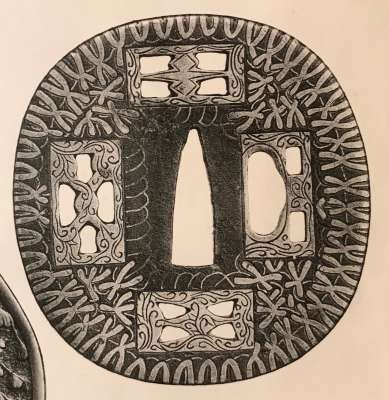 Fig. 7. Naunton Collection, №52. |
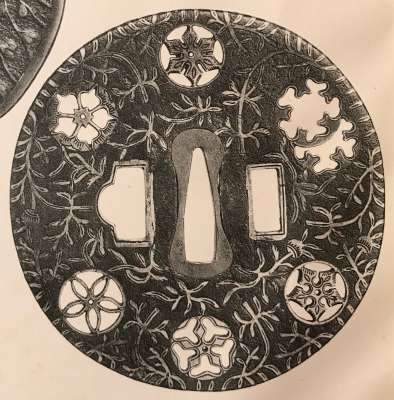 Fig. 8. Naunton Collection, №65 |
 Fig. 9. Naunton Collection, №74. |
Fig. 7. Naunton Collection, №52: “Iron, rounded square, inlaid in hirazōgan with a coarse brass pattern of water weed (Mō) or conventional fir; perforated with four oblong holes filled with brass plugs, also perforated in designs vaguely reminiscent of crests and engraved on the surface. Ex Hawkshaw Collection. XVII century.”
Fig. 8. Naunton Collection, №65: “Iron, circular, with six mon. XVII-XVIII century.”
Fig. 9. Naunton Collection, №74: “Iron, with eight crests in brass small tree decoration hirazōgan. XVII-XVIII century.” Nothing is said about the signature (see below).
The true meaning of the symbolism of №52 will be revealed later on (see below Fig. 49). None of these examples are signed. However, there is one tsuba in this collection, though not illustrated, which is signed: “Izumi no Kami Yoshirō Koiké Naomasa: №103 – Iron, sixteen godrons, chrysanthemoid inlaid with brass tendrils and paulownia, silver and copper hirazōgan. XVIII-XIX century.” Joly dates Naomasa’s work in Naunton Collection on 18th-19th century. Torigoye’s age attribution was “about the Kanchō [Keicho] era (1596-1614), or Genna (1615-1623)”. Comte de Tressan have seen a tsuba with the year 1533 on it.
№52 has a reference to Hawkshaw Collection [7]. The tsuba in question is not illustrated there but seems to be described under №9: “Iron, rounded square, inlaid in hirazōgan, with a coarse brass pattern of water weed (Annularia?); perforated with four oblong holes filled with brass, plugs also perforated in designs vaguely reminiscent of crests and engraved on the surface. XVII century.
In Hawkshaw Collection there are a few examples of tsuba signed by Yoshirō:
№15: Iron, chrysanthemoid outline with sixteen godrons inlaid all over with hirazōgan with paulownia, the branches stylized to brass scrolls, the flowers to crest; Inlaid copper, silver, brass, respectively (silver inflorescence where the leaves are of another metal). Signed: Koiké Naomasa, Izumi no Kami, Yoshirō.” This description looks very much alike the one of №103 in Naunton Collection.
№16: Iron, rounded oblong, chrysanthemoid outline with sixteen lobes. Signed: Izumi no Kami, Yoshirō, Koiké Naomasa.
It is unclear why the signature in these two tsuba lists the words in different order. What is clear, however, is that none of these signed tsuba are of mon-sukashi design. Age is not specified.
The next mention of Koiké Yoshiro Naomasa was found at “Japanese art and handicraft” [8] by the same Henri L. Joly:
“Inlays of Onin, Kyoto, Fushimi-Yoshiro, and Kaga Province:
…Kyōto inlays follow the style of the older Shoami and are in relief; the true Yoshiro work, originated by Koiké Yoshiro Naomasa in hira-zōgan technique, consists chiefly of crests, much imitated later in Kaga with poorer iron bases; the work of Nagayoshi is among the best in Heianjo zōgan, with or without sukashi. Kaga work derived from that of the Yoshiro atelier is also in hirazogan, but the edge is square and occasionally inlaid; other Kaga workers followed the Goto, who, like the Yoshiro workers, went to Kaga about Keichô period to work for the Meada family.”
The Maeda clan ruled the Kaga Domain from their headquarters in Kanazawa from 1583. If Naomasa was active in Kyoto in 1533, say, he was 20 year old, then in 1583 by the time he moved to Kaga he might be at least 70. Being in Kyoto Naomasa worked back to back with some Nagayoshi who was “among the best in Heianjo zōgan”.
Who’s Nagayoshi? №132 and №133 provide descriptions (though, no illustrations) of tsuba, signed by Nagayoshi (Chokichi) of Yamashiro, 16th-17th century. Yamashiro is almost Kyōto, the hometown of Heianjo technique, and of Koike Yoshirō Naomasa, who might have been a disciple or a co-worker or a competitor of the said Nagayoshi.
Nagayoshi of Yamashiro.
To understand whether the Naomasa’s work has anything in common with the Nagayoshi’s work, I show here what I’ve got about Nagayoshi’s tsuba so far:
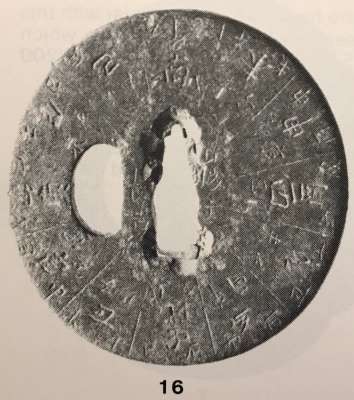 Fig. 10. Catalog #6. Robert E. Haynes, 1983. №16. |
 Fig. 11. Catalog #9. Robert E. Haynes, 1984. №60. |
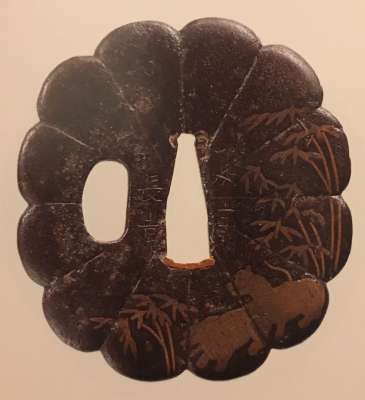 Fig. 12. Lundgren Collection, 1992. №9. |
Fig. 10. “Rare signature of Heianjo Nagayoshi. “The well forged plate in great detail with the zodiac, which is repeated on the reverse side. It was all inlaid with silver but most missing now. […] Heianjo Nagayoshi was one of the first great inlay artists of Kyoto. He lived ca. 1575, which is 50-100 years before Heianjo brass work was signed and over 150 years before Kaga brass inlay tsuba were signed” [9].
Fig. 11. “Highly important classic example of the work of Heianjo Nagayoshi. […] The brass inlay goes over the edge of the plate and the head of the dragon is touched with silver inlay. The face is signed: Heianjo ju Nagayoshi saku. Ca. 1575. 70 mm (H) x 5.25 mm (Th., center), 4.5 mm (Th. edge)” [10].
Fig. 12. “Sword guard with design of bamboo and tigers. Signed by Nagayoshi of Yamashiro. Heianjō inlay school. 76.0 x 70.0 x 3.5 mm. Iron. Flat brass inlay. Momoyama – Edo Period, 17th century” [11].
 Fig. 13. Lundgren Collection, 1992, №137. |
 Fig. 14. Lundgren Collection, 1992, №7. |
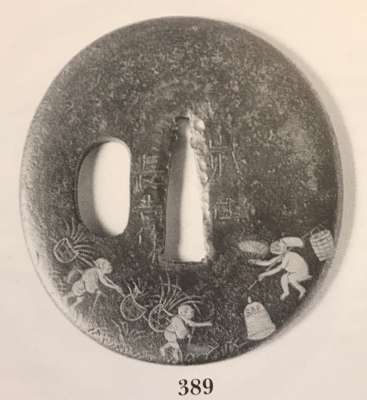 Fig. 15. Sotheby’s, London on November 17, 1994. №389. |
Fig. 13. “Sword guard with design of a dragon in openwork. Signed by Nagayoshi. Heianjō inlay school. 56.0 x 61.0 x 3-15 mm. Niku-bori-jisukashi openwork and copper inlay, Momoyama – Early Edo period, 17th century” [11].
Fig. 14. “Sword guard with design of mythical turtles. Signed by Nagayoshi of Yamashiro. Heianjo inlay school. Polished iron. Flat brass inlay. 79 mm x 74 mm x 4.0 mm (rim). Momoyama-Edo Period, 17th century. Same piece is illustrated as №11 at Christie’s, 1997” [12], and at Robert Haynes’s Study Collection of Japanese Sword Fittings [13] on page 69:“Iron oval plate with flush brass inlay of three minogame and waves. Signed: Yamashiro jū Nagayoshi saku. Lived in Kyoto in Momoyama period” [11].
Fig. 15. “A small Fushimi tsuba by Yamashiro Nagayoshi. Momoyama / early Edo period (early 17th century). Inlaid in copper, brass and silver hinzogan. Signed: Yamashiro ju Nagayoshi saku. Ex. Henri Vever Collection” [14].
With the exception of Fig. 13, all other tsuba, signed by Nagayoshi, are in hira-zōgan (flush inlay) of brass, or of brass, silver, and copper combined. Haynes dates Nagayoshi’s work 1575, and Naomasa’s tsuba in Jacoby collection is dated 1533. It’s hard to tell who learned from whom (Naomasa from Nagayoshi or vice versa), but in 1575 Naomasa was likely still in Kyoto (if he moved to Kaga in about 1583).
Saburodaiyu.
If Nagayoshi helps us understand the origins of Naomasa’s style, Saburodaiyu’s work may assists us with comprehension of what had happened to mon-sukashi technique after Naomasa. A fine example of a signed mon-sukashi tsuba can be found at “Japanese art and handicraft”:
 Fig. 16. Japanese art and handicraft, №129. Naunton Collection № 74, 17th century. |
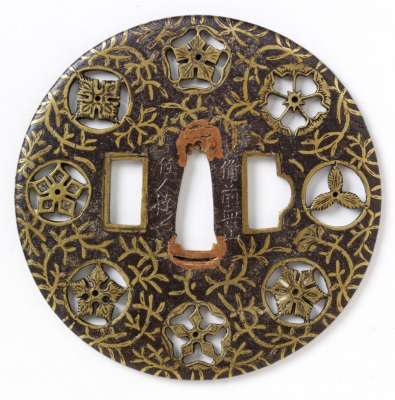 Fig. 17. Victoria and Albert Museum. Hakayama Saburodayu, ca. 1600-1650 |
 Fig. 18. The Caldwell Collection, №32 — Hakayama Saburodaiyu. Momoyama period. |
Fig. 16. Japanese art and handicraft [15], №129: “Iron, Mon-Zukashi type inlaid with “small pine tree” pattern and with crest à jour in brass, Kaga Yoshiro, signed Bizen Okayama no Jiu nin Saburo daiyu, 17th century”. This is the same tsuba as in the Naunton Collection [6] under № 74 , though in the latter the signature is not mentioned, neither there is any word of Kaga or Bizen or even Yoshirō in description.
Fig. 17. Victoria and Albert Museum, Place of origin: Okayama, Date: ca. 1600-1650, Artist/Maker: Hakayama, Saburodayu. Iron with brass plugs and inlaid brass. Museum number: M.203-1921 Gallery location: Japan, Room 45, The Toshiba Gallery, case 1. http://collections.vam.ac.uk/item/O192664/tsuba-hakayama-saburodayu/. We see that the V&A example is the face of the same tsuba that is illustrated by Henri L. Joly in both Naunton Collection and Japanese art and handicraft.
Fig. 18. The Caldwell Collection [32], №32 — “Hakayama Saburodaiyu. A circular iron tsuba pierced in negative and positive sukashi with six heraldic crests inlaid among foliage in brass hira-zogan. The hitsu-ana plugged in brass. Signed: Saburodai saku yuki, Momoyama period. 81 x 81 x 3 mm. Note: Saburodaiyu was from Okayama in Bizen province. Although similar to those made by the Yoshiro Naomasa School, this tsuba is the Bizen Yoshiro School. The inset plugs at the seppa-dai are typical of some Bizen schools, such as Yoshiro and Suruga”.
So far I only managed to find two signed Saburodaiyu tsuba. Both are said to be made in Okayama in Bizen province, either in Momoyama period or in early Edo period, though the dates are inferred but not explicitly indicated on the pieces.
Koike Yoshirō Naomasa.
(1) There is one signed tsuba from Gustav Jacoby collection, which is probably now held in The Hermitage Museum. Tuba is dated 1533, but we don’t know how it looks like yet. Jacoby’s catalogue should arrive in February 2018, and I only hope that it is illustrated there. Another possibility is to get a photo of the said tsuba from the Hermitage.
(2) The other signed example was found in Naunton collection under №103, though without the illustration. It is signed: “Izumi no Kami Yoshirō Koiké Naomasa”. Description: Iron, sixteen godrons, chrysanthemoid inlaid with brass tendrils and paulownia, silver and copper hirazōgan. XVIII-XIX century.” [SV:We certainly can reject this dating.]
Two more signed tsuba in the Hawkshaw Collection:
(3) №15: “Iron, chrysanthemoid outline with sixteen godrons inlaid all over with hirazōgan with paulownia, the branches stylized to brass scrolls, the flowers to crest; Inlaid copper, silver, brass, respectively (silver inflorescence where the leaves are of another metal). Signed: Koiké Naomasa, Izumi no Kami, Yoshirō.”
(4) №16: “Iron, rounded oblong, chrysanthemoid outline with sixteen lobes. Signed: Izumi no Kami, Yoshirō, Koiké Naomasa”.
In Robert Haynes’s Catalog #7 [23] we finally see (not just read about) tsuba with the actual Yoshirō Koike Naomasa signature. Another signed tsuba is in the Dr. Walter A. Compton Collection (part I) [28]:
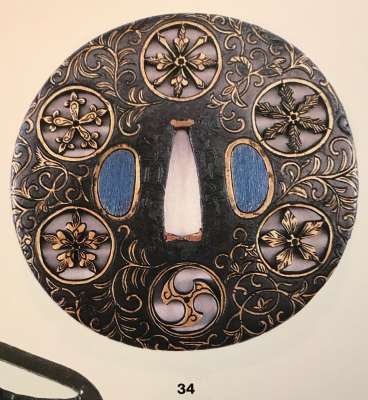 Fig. 19. R. Haynes, #7, 1983. №34: Masterpiece tsuba by Koike Yoshiro Naomasa. |

|
 Fig. 21. Compton Collection (II): №11. Signed Koike Yoshiro. |
(5) Fig. 19. — “Masterpiece tsuba by Koike Yoshiro Naomasa. […] The six mon are solid brass inlay. […] The later work of the Bizen Yoshiro and Saburodaiyu continued this style and in some cases equaled it. From Mosle. 84 mm (H) x 3.75 mm (Th., center). Classical signature.”
(6) Fig. 20 — “Very fine middle period example of the work of Naomasa. […] Inlay slightly raised. […] See: Jack Paras sale, catalogue May 26, 1981, lot 5. From Moslé collection. 81 mm (H) x 3.5 mm (Th., center).”
(7) Fig. 21. —“A Koike School tsuba, Edo period (circa 1625), signed Koike Yoshiro. Sheet-brass flush inlay of cloud forms and wire inlay creating the same shape. Koike Yoshiro Naomasa worked from the Keicho to the Genna periods (1596-1623). He arrived in Kyoto from Kaga.” [SV: A good portion of confusion was just infused. Naomasa arrived in Kaga from Kyoto, and not vice versa. “The Keicho to the Genna” is October 1596 to February 1624, though 1625 is the Kan’ei era. It is clear, that Robert Haynes was unaware of the Jacoby’s dated specimen’s inscription, or did not trust it].
 Fig. 22. The Henry D. Rosin Collection, 1993; №21 on page 40: Koike Yoshiro Naomasa. |
 Fig. 23. Alexander G. Mosle Collection, №43. Signed: Izumi no Kami Naomasa Koike Yoshirō. |
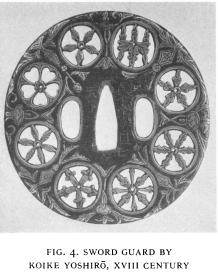 Fig. 24. Metropolitan Museum of Art. |
(8) Fig. 22. The Henry D. Rosin Collection [34], №21 on page 40 — “Koike Yoshiro Naomasa. Circular iron tsuba with heraldic designs, the plate decorated with karakusa in brass hira-zogan. Signed by Koike Yoshiro, inscribed Tenka Ichi. Momoyama period. 84 x 85 x 3 mm. Certified box by Torigoye Kazutaro (1965). Provenance: W.W. Winkworth; John Harding. Illustrated: Torigoe, Tsuba Kanshoki, plate 48. Similar examples: Kümmel, Sammlung G. Oeder, page 11. Wakayama, Toso Kodogu Koza, vol. 1, sec. 2, page 80, vol. VIII, page 70. Note: Koike Yoshiro Naomasa became a master of the Yoshiro School sometime during the third quarter of the 16th century. The tsuba produced by this school were traditionally decorated in brass, silver and shakudo hira-zogan. Koike Yoshiro took this style and technique to an unprecedentedly high level of accomplishment. His only known dated work is of Tensho 3 (1575). The inscription “Tenka Ichi”, freely translated as “The Best Under Heaven”, refers to Yoshiro’s personal view of this particular work which he regards as unsurpassed. His signed work is considered to have been made-to-order only”. [SV: The catalogue was prepared by Patrick Syz, who was assisted by John Harding, a renown authority. However, like Torigoye and Haynes, Harding does not mention the Jacoby’s tsuba of 1533].
(9) Fig. 23. Alexander G. Moslé Collection [35], №43 — “Koike Yoshiro (active late 16th – first half of 17th century). Tsuba with heraldic crests and vine tendrils. Mokko-form iron plate pierced and inlaid with brass wire. 68 x 67 mm. Signed: Izumi no Kami Naomasa Koike Yoshirō. Koike Yoshirō’s technique evolved from the Onin style. His signature rarely found.”
(10) Fig. 24. One more signed example can be found at BULLETIN OF THE METROPOLITAN MUSEUM OF ART VOLUME XXXII NEW YORK, OCTOBER, 1937 NUMBER 10; Japanese metalwork, Nō masks, and textiles in the Howard Mansfield Collection, pp. 228-238: “There is a noteworthy group of guards in the Yoshiro style, which is characterized by brass inlays in slight relief, combined with crests in openwork. The name Yoshiro is derived from that of Koike Yoshir6 who also signed his work Naomasa with the title Izumi-no-Kami. A guard with these characteristics and the latter signature is further inscribed with a Cellini-like boast that the artist is “second to none.” [This is probably the inscription “Tenka Ichi”, mentioned in Fig. 22]. This is a better view of the MET’s tenka-ichi (天下一, “second to none”) tsuba:
Then, there are three almost identical tsuba, signed Koike Naomasa:
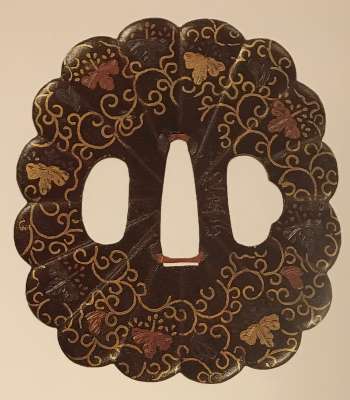 Fig. 25. Tsuba by Günter Heckmann. T55: Signed: Koike Naomasa. Mid Edo, end of the 17th century. |
 Fig. 26. Koike Naomasa tsuba in The Varshavsky Collection. Late Muromachi – Momoyama period, late 16th century. |
 Fig. 27. R. E. Haynes Catalog #7: № 32 — “Early signed example of the work of Koike Naomasa”. |
(11) Fig. 25. Tsuba by Günter Heckmann [31], T55 — “Designation: Koike Naomasa. Mid Edo, end of the 17th century. Iron, hira-zogan in brass, copper, silver and shakudo, katakiri-bori. Tendrils and leaves. 87.0 x 78.0 x 4.0 mm.” Reference: Japanische Schwertzierate by Lumir Jisl, 1967, page. 13. [SV: Actually, his tsuba is signed Izumi no Kami Yoshiro on the back; and Koike Naomasa on the front, exactly as Robert Haynes’s tsuba. Dating this tsuba Mid-Edo, 17th century may be considered a misattribution].
(12) Fig. 26. Koike Naomasa Tsuba. The style of Heianjo brass zōgan of ivy and silver and copper suemon zōgan of paulownia. In wooden box with hakogaki by Torigoye at Showa 39th. Size: 83.0 mm x 80.0 mm x 4.3 mm. Tokubetsu Hozon paper. The Varshavsky Collection, SKU: TSU-0346. 89 mm x 84 mm x 3.6 mm, 170 g.
(13) Fig. 27. R. E. Haynes Catalog #7 [23]: № 32 — “Early signed example of the work of Koike Naomasa. The kiku shape iron plate is well finished. The flush inlay is brass, for the scroll work on both sides, woth the leaves and kiri mon in brass, copper and silver with strong detail carving. Some of the inlay goes almost over the edge, which is goishi gata. The large hitsuana are plugged in lead with starburst kokuin surface design. […]The face is signed in deep bold kanji: Koike Naomasa; the back is signed: Izumi no Kami, on the right and Yoshiro on the left. There are one or two small pieces of inlay missing. Sold by Sotheby London, Oct. 27, 1981, lot 368. Height = 86 mm, thickness (seppa-dai) = 3.75 mm, (edge) = 4 mm.”
Seems like it was almost a mass production, though for the imperial family, as these tsuba bear all the imperial symbols: they are in chrysanthemum form and inlaid with a paulownia, an explicitly imperial crest, only slightly behind the chrysanthemum [John W. Dower]
Two more signed specimens are illustrated by Gary D. Murtha [1]:
 Fig. 28. Gary D. Murtha. Page 138. Signed: Izumi no Kami Koike Naomasa. Erly Edo period. |
 Fig. 29. Gary D. Murtha. Page 158: Signed Yoshiro Naomasa. |
(14) Fig. 28. Gary D. Murtha. Japanese Sword Guards. Onin-Heianjo-Yoshiro, 2016. Page 138: “Iron, 64 x 58 x 5 mm, yatsu-mokko, tsuba with brass geometric pattern of a jakago (woven basket) with brass raimon border. Signed: Izumi no Kami Koike Naomasa. Erly Edo period.” The location of this tsuba is not indicated. It may be in Mr. Murtha’s possession.
Fig. 29. Gary D. Murtha. Japanese Sword Guards. Onin-Heianjo-Yoshiro, 2016. Page 158: “Iron, signed Yoshiro Naomasa tsuba with copper, brass, and silver 3-5-3 Paulownia crests with brass naten karakusa background inlay. Nanako punched, pewter ryo-hitsu. Azuchi-Momoyama to early Edo period.” Same tsuba in black and white is illustrated at R. E. Haynes Catalog #7 under № 32 (see above).
(15) Finally, there is one more tsuba with description only (no image): in the collection of “the late general J. C. Pabst” [18] on page 26, lot 15: “Iron, octangular with rounded angles, small. In usu-niki-bori (chiseled in low relief): the prayer of the Buddhist Nichi-ren sect: Na-mu miō ho ren-ge kiō (Glory to the book of the lotus of the good Law) and in shinchū-suji-zōgan: a rinzu-pattern. Signed: Ten-ka-ichi (title) Ko-ike Nao-Masa Izu-mi-no-Kami (title).” In the J. C. Hawkshaw Collection there is an item under №13: “Iron, mokko shape, inlaid on one side with a rinzu pattern in brass wire hirazōgan, on the other with the sentence Namu Mio Hō Renge Kyo, mantra of the Nichiren sect. 17th century”. Could it have happened that H. L. Joly missed the Koike Naomasa’s signature? The inscription “Tenka Ichi“, freely translated as “The Best Under Heaven” was used by Yoshiro from time to time, as we know. This particular tsuba does not seem to be of a brass mon-sukashi type.
(16) Tsuba illustrated on Fig. 4, that is signed Koike Yoshirō Izumi no Kami Naomasa (from “Tsuba. An Aesthetic Study”.)
Altogether I found 16 signed examples of Koike Yoshirō Naomasa tsuba. [Actually, a few more as of October 20, 2022]. They can be visually discriminated into three different designs: (1) Chrysanthemoid form tsuba with 16 petals, decorated in flush inlay with vines (karakusa) in brass and paulownia crests in copper and silver – six of those, though the three without images (number 2, 3, and 4) may be the same as number 11, 12, and 13; (2) Mokko form tsuba, decorated in slightly raised (almost flush) inlay of brass: the plate is covered with rings and netting or fish scale (uroko) motif, while the raised rim is bearing continuous meander-type pattern (inazuma, lightning), or with flush inlay of cloud-like forms and silver wire inlay – three of those, number 6, 7, and 14; (3) A circular or mokkō form iron tsuba with solid brass pierced and carved roundels (heraldic designs), the plate decorated with vines (karakusa) in brass flush inlay (hira-zōgan) – four of those, number 5, 8, 9, and 10.
It is likely that Koike Naomasa lived from the late 16th century to the early 17th century, i.e. Momoyama – early Edo period.
Other tsuba signed by a “Yoshirō”.
There are three tsuba, signed by some Yoshiro, though not by Naomasa:

Fig. 30. Carlo Monzino Collection, №6. A Bizen Yoshirō monsukashi tsuba. Signed: Yoshiro saku kore.
Fig. 30. The Carlo Monzino Collection [36], №6 — “A Bizen Yoshiro monsukashi tsuba. By Yoshiro (Koike), Momoyama period. Pierced with floral mon and a hitsu-ana, the flowers and surrounding karakusa of inlaid brass hira-zōgan. Signed: Yoshiro saku kore. 75 mm diameter.” [Though, Torigoye/Haynes stated that this is not a signature of Naomasa, but of a later Bizen Yoshirō master].
Another tsuba signed “Yoshiro Saku Kore” is illustrated in Fig. 5. And one more in the same book (here in Fig. 6) signed: “Bizen Yoshirō Nagatsugu Saku Kore”. Both tsuba are from “Tsuba. An Aesthetic Study”. The same source reports one tsuba (not illustrated) with the signature “A lucky day in August of 1697, Bizen Yoshirō Nagatsugu made this”.
Unsigned Yoshirō tsuba
Let’s quickly review the data on unsigned tsuba attributed to Koike Yoshirō, images and descriptions of which I have managed to find in available resources.
Edgar Jepson wrote in The Connoisseur in 1924, pp. 144-152 [17] (Fig. 31):
“№ 10 is an example of the Fushimi-Zogan, a flat inlay of a light-coloured bronze. These tsuba took their name from the fact that they were first forged at Fushimi, in Yamashiro, in the sixteenth century. It is in the type known as Mon-sukashi, perforated with crests (mon) à jour. The Yoshirō-zogan tsuba were also first forged at Fushimi by Yoshiro Naomasa. They were distinguished from the Fushimi-zogan by the fact that their inlay was generally a little raised – not always – for the inlay of № 9, a tsuba forged by a later nineteen century Yoshirō, is quite flat.”

Fig. 31. Fushimi-Zogan and Yoshirō-zogan tsuba.
Besides the fact that the two tsuba’s numbers ascend from right to left, the pieces are depicted upside down. The author calls”Mon-sukashi” the two overlapping circles in openwork on the left tsuba (№10); he does not use this term in the description of the tsuba №9. The “later nineteen century Yoshirō” also raises a question, however there is a theory speculating that many (if not most) mon-sukashi Yoshirō tsuba were made in the docks of Yokohama and sold to the Westerners as souvenirs at the end of the 19th century.
Two tsuba in The Peabody Museum collection [19]:
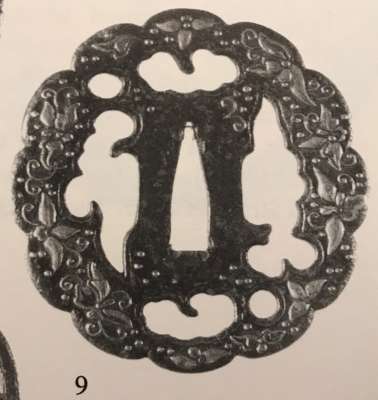 Fig. 18. Attributed to Koike. Yoshiro style, c. 1570-1590. |
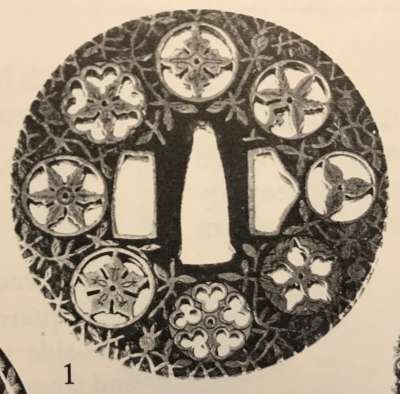 Fig. 19. Yoshiro type, c. 1600. |
Fig. 32. — “Sheet VI, № 9 — “Iron, twelve-lobed shape. Raised brass inlay of ginko leaves. The irregular Ryohitsu and cloud-like piercings are peculiar to Yoshiro work. Attributed to Koike. Yoshiro style, c. 1570-1590”. According to Torigoye, the “irregular Ryohitsu” is a pathognomonic symptom of Bizen Yoshirō school, but this might not have been know in 1957. It is also not clear where the author sees the ginkgo leaves.
Fig. 33. — Sheet VIII, № 1 — “Yoshiro type, c. 1600: Iron, circular. Eight crests (mon) in saw-pierced positive silhouette (mon Sukashi) and vines of flat brass inlay (Hira Zogan)”. This tsuba is almost identical with the one under №9 in the Mr. Jepson paper. The discrepancy in age attribution is remarkable — almost three hundred years: early 17th century vs. late 19th.
We already noticed that any brass inlay tsuba may have borne the name of Yoshirō or Fushimi-Yoshirō in the past, and this fact creates a lot of confusion. Mon-sukashi term is similarly confusing: some just call any family crest themed openwork “mon-sukashi”. But even if we only focus on iron tsuba with some sort of arabesque (karakusa, water weed, conventional fir, mogusa, tendrils, vines, etc.) brass inlay, with the insertions of the round-form “à jour” (openwork, sukashi) emblems (crests, mon, flowers) also made of brass, we see that the age attribution poses a problem. Kaga or Bizen Yoshirō designation is even more confusing. Besides, the Torigoye/Haynes taxonomy of Yoshirō tsuba further discriminates Kaga Yoshirō into Style One and Style Two. Here we have three mon-sukashi tsuba, attributed by Robert Haynes to Bizen Yoshirō school:
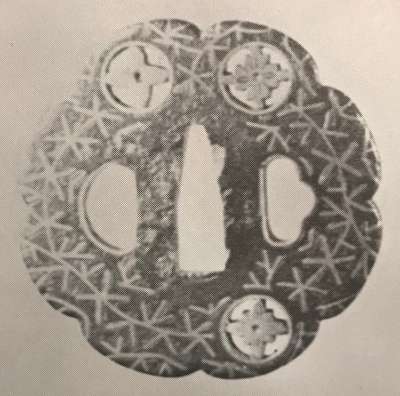 Fig. 34. R. Haynes, 1981. №9: Brass inlay in Bizen school style, ca. 1575. |
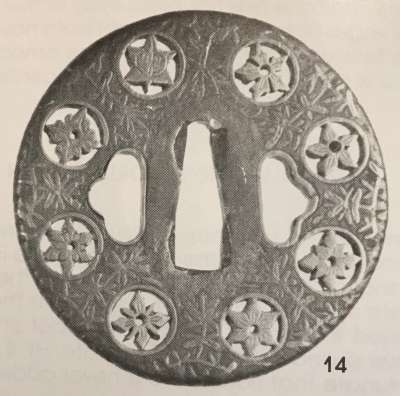 Fig. 35. R. Haynes, 1982. №14: Bizen mon sukashi tsuba, ca. 1700.” |
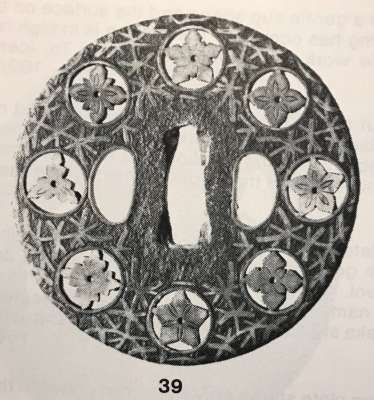 Fig. 36. R. Haynes, 1983. №39: Saburodayu school work, ca. 1725. |
Fig. 34.— “The hachi mokkō shape tapers to the edge and the brass inlay goes over the edge. The mon are solid brass, as are hitsu-ana liners. A classic later unsigned example of brass inlay style of Bizen Prov., ca. 1725. 70 x 4.5 mm.” [20]
Fig. 35. — “Classic example of later Bizen mon sukashi tsuba. […] This type was first made in Bizen but later other copied them. This seems to be an original Bizen piece, ca. 1700. 74 x 4 mm.” [21]
Fig. 36. — “Classical later Saburodayu school work. This style is also called Koike Yoshiro of Bizen and would be the work of a student of the first or second generation, ca. 1725. 78.0 x 4.0 mm.” [22]
These descriptions are relatively consistent with “Tsuba. An Aesthetic Study”: “It is clear that there were two generations who used the name Bizen Yoshirō. The first generation worked about Kambun era (1661-1672). The second generation worked about the Genroku era (1688-1703)”.
In the Catalogs # 8 and #9 Robert Haynes shows us “the origin of Koike Yoshiro Naomasa style”[24] and the work of an alleged Naomasa’s disciple [25]:
 Fig.37. Catalog #8. R. Haynes, 1984. №39: Early example of Koike style, ca. 1400. |
 Fig.38. Catalog #9. R. Haynes, 1984. №47 Face. Unrecorded signature of Masaiye,ca. 1650. |
 Fig.39. Catalog #9. R. Haynes, 1984. №47 Back. |
Fig. 37. — №39 — “Very fine and interesting early example of Koike style. The brass inlay in the style we associate with Koike Yoshiro Naomasa. In this case the work is earlier than the first Naomasa and shows the origin of his style. Ca. 1400, 70 mm (H) x 4 mm (Th).”
Fig. 38 and 39. — №47 Face — “Unrecorded signature of Masaiye, a student of Koike Naomasa. Signed on the back: Masaiye saku. From the old French collection. Ca. 1650.”
Koike Yoshiro Naomasa was active in 1533 and in 1575. It’s hard to imagine that he derived his style from ca. 1400 technique. His student could have been alive and active in 1650 still making tsuba in the style of his late mentor, who should have died some 50 years ago.
The Collection of Dr. Walter A. Compton (Part II) [26] provides us with another example of the origins of the Yoshirō style, but does not send us to the beginning of the 15th century:

Fig. 40. Compton Collection (II), №31. Momoyama period (ca. 1575).
Fig. 40. — №31: “A proto-Koike Yoshiro tsuba. Momoyama period (circa 1575). The round iron plate is pierced and insert with eight reticulated, solid brass, pierced crest (mon sukashi) roundels and is decorated with a ground of inlaid brass vine leaves and tendrils flush to the surface. The inlay rolls over the rounded edge of the plate and the pierced apertures (hitsu-ana)retain their original brass outline which are in the classic shape found on many tsuba made from the middle to late Muromachi period (1450-1550). Provenance: Hotel Drouot, 23 March, 1970, lot. 397.” Why this tsuba is considered “a proto-Koike Yoshiro” remains unclear. We know for sure that Naomasa was making tsuba in 1575.
Another confusing age attribution is presented at “Tosogu. Treasure of the samurai” [27]:
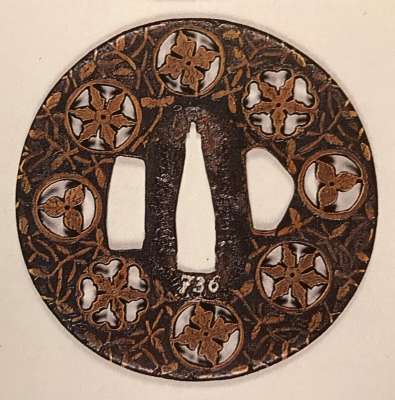
Fig. 41. Tosogu. №22: Mid-Muromachi mon-sukashi tsuba.
Fig. 41. — “Heianjo iron tsuba with brass mon sukashi design. Middle Muromachi period. […] examples of Mid-Muromachi mon-sukashi tsuba show that it was the inventive Haianjo School that started the design and the later Yoshiro School that popularized it.” The image indicated to be from the Phyllis Sharpe Memorial Collection, though it is not illustrated in the Sotheby’s catalogue, 1997. Dating a mon-sukashi tsuba to Mid-Muromachi period, even being in line with the earlier 1400 attribution on Fig. 37, seems doubtful.
A few other examples of unsigned tsuba attributed to Koike Yoshirō Naomasa can be found at Compton’s Collection, part II [26] and III [29].
 Fig. 42. Compton Collection (II), №29: A tsuba in the style of Koike Yoshiro Naomasa, circa 1625. |
 Fig. 43. Compton Collection (III), №11: A tsuba in the style of Koike Yoshiro. Edo period, circa 1625. |
 Fig. 44. Compton Collection (III), №12: A tsuba in the style of Koike Yoshiro. Edo period, circa 1700. |
Fig. 42. “A tsuba in the style of Koike Yoshiro Naomasa. Edo period (circa 1625). 83 mm x 4 mm. This style of tsuba was perfected by the Koike family in Kyoto but was later manufactured at Kanazawa in Kaga. Signed examples are found from both Kyoto and Kaga and it is thought that these represent special orders. Naomasa was the most famous member of the large Koike family school”. The same tsuba is presented in “One hundred masterpieces” under №46 [30] on page 233.
More unsigned tsuba:
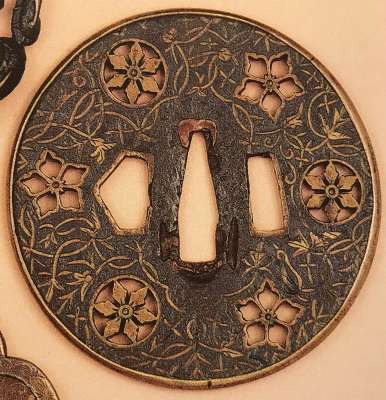 Fig. 45. Lundgren Collection,№138. Momoyama—Edo, 17th century. |
 Fig. 46. Tsuba. Günter Heckmann. T46. Early Edo, 17th century |
 Fig. 47. Caldwell Collection, №31. Momoyama. |
 Fig. 48. KTK 7. 7-C11. Momoyama—Early Edo (end of 16th century). |
Fig. 45. — Lundgren Collection [11], №138 — Sword guard with design of Chinese bellflowers in openwork. Unsigned. By Yoshirō. Koike Yoshirō School. Iron. Openwork and brass inlay. 83.0 mm x 83.0 mm x 5.0 mm (rim). Momoyama-Edo Period, 17th century. Christie’s, 1997 [12], №40 — This Yoshiro tsuba falls into the category of Heianjo zogan, which was popular in the Momoyama period just after Heianjo zogan tsuba were begun to be made. The combination of elaborate zogan and small sukashi won favour with the samurai.
Fig. 46. — Tsuba by Günter Heckmann [31], №T46 — Unsigned, Yoshiro style. Early Edo period, 17th century. Iron, yoshiro-zogan in brass. “During the 16th century one of the centers for brass inlays in iron, was Fushimi, a suburb of Kyoto. […] Koike Yoshiro Naomasa was a former manufacturer of stirrups at Fushimi. From his name the term yoshiro-zogan originates and is mostly applied to works of so called “mon-sukashi” technique: in circular openwork patterns, various family crests are placed in positive or negative silhouettes.
Fig. 47. — Randolph B. Caldwell Collection [32], №31 — Yoshiro. An iron tsuba of mokkō shape pierced with mon-sukashi, the plate decorated with bamboo in brass hira-zogan. Unsigned. Momoyama period. 79 x 82 x 3.5 mm. Note: Traditionally the Yoshiro School produced tsuba decorated in silver, brass and shakudo hira-zogan. It was Koike Yoshiro Naomasa, active in the second half of the 16th century, who took the technique and style to the highest level.
Fig. 48. — Kokusai Tosogu Kai 7th, 2011 [33], №7-C11 — Unsigned, attributed to Yoshiro School. Kamon (family crest) motif. Iron plate with shinchū (brass) inlay. Circa: Momoyama — Early Edo period (end of 16th century). 86.61 x 86.87 x 3.81 mm. “This maru gata tsuba with maru mimi is made from tetsu (iron) with shinchū (brass) inlay and positive sukashi openwork depicting mon, flowers, and vines. It is attributed to Koike Yoshiro Naomasa, and is an excellent example of early Kaga Yoshiro zōgan work. Naomasa worked in the Momoyama to the early Edo period. He is said to be a native of Kyoto and later moved to Kaga province. Naomasa’s style of inlay was different from the “native” kaga zogan methods, which remained different from his Kaga Yoshiro style of work. The work Naomasa did in Kyoto has the same floral brass inlay work, but none of the openwork that characterizes his later Kaga Yoshiro style. Bill Taylor Collection, Canada. [SV: isn’t it an amazing precision of measurement? One-hundredth of a millimetre!]
As I mentioned before, Torigoye/Haynes book “Tsuba. An Aesthetic Study” is the main source of information about Yoshirō tsuba (and not only). In this book the authors suggest the following classification of Yoshirō tsuba:
|
Feature |
Kaga Yoshirō, Style One | Kaga Yoshirō, Style Two |
Bizen Yoshirō |
| Shape | Mostly round, oval, mokkō or kiku-gata (chrysanthemoid) | Oval or kiku-gata | – |
| Thickness | 3 – 4.5 mm | The center is thick tapering to the edge (goishi-gata, shape of a go piece). [No thickness data]. | – |
| Seppa-dai | Similar to Heianjō-zōgan style. [Not described elsewhere] | – | – |
| Hitsu-ana | Elegant, elongated ellipse, similar to Kyō-sukashi school [which is: elongated oval shape, very graceful and elegant] | – | Large, of undulating cloud forms. |
| Edge | Round | Round | – |
| Plate metal | Iron, generally of the same hardness as Heianjō-zōgan work (which is: iron, usually soft and not of very good quality), usually of good quality. [Nothing is said about the surface]. | Iron of fine silky polished surface. [Nothing is said about the hardness]. | – |
| Forging | Quite good | – | – |
| Designs | Flat brass inlay of floral designs with large openwork circular inlays of mon or flowers, several in number spaced evenly around the web. It is common to find a shallow line cut where the brass inlay meets the plate. The openwork mons and flower subjects in Koike work will generally be more delicate than other schools who used this type of inlay. | Floral motif of karakusa. No brass openwork mon or floral designs as in the first style. | – |
| Signatures | Izumi (no) Kami Naomasa and on the reverse Koike Yoshiro. Naomasa, Masaiye. | The signature “Izumi (no) Kami Koike Naomasa” is used rarely. Koike Kichirō Naomasa, Koike Yoshirō Norisada. | Yoshirō saku, Yoshirō kore (wo) tsukuru. Umon Nagatsugu, Koike Umon Nagatsugu, with Okayama jū nin on the back. Bizen Yoshirō Nagatsugu saku. |
| Inlay | – | Brass, silver, and copper. Sometimes all three on a single piece. | Shakudō and gold in addition or instead of brass. |
From this table we can gather that unsigned Kaga Yoshirō pieces may be classified as with mon-suckashi and without them, the latter may have silver and copper inlay besides brass. Bizen Yoshirō tsuba may have other inlays than brass, and large cloud-formed hitsu-ana. That’s pretty much it. Tsuba made by Naomasa in Kyoto are classified here as the Kaga Yoshirō tsuba, which seems strange to me.
What do we know so far (instead of a summary):
I believe that we have enough evidence to state that Koike Yoshirō Naomasa lived in Kyoto (Heian-kyō, Fushimi, Yamashiro province, the Imperial court seat and the Shogun seat), where he learned the Haianjō technique of brass inlay. There he was producing tsuba since at least 1533. It seems that during this time the most capable tsuba-ko of Kyoto started to transform the Heianjo style, making inlays more flat and supplementing brass with silver and copper in their work. We see this tendency both in works of Naomasa and Nagayoshi. We may assume that Naomasa produced tsuba to order for the imperial court (Fig. 25-27).
Naomasa also experimented with somewhat ‘foreign’ or namban, manner (Fig. 20 and 28). We do not know at what period of his career he started to make tsuba with “the round iron plate, pierced and insert with reticulated, solid brass, pierced crest (mon sukashi) roundels and decorated with a ground of inlaid brass vine leaves and tendrils flush to the surface”, which later acquired the name of ‘mon-sukashi tsuba’. Though, even if we accept this term, we have to admit that the shape of the ‘reticulated, solid brass, pierced’ roundels of his signed examples do not look like family crests. To me they look more like stylized flowers or snowflakes.
In about 1583 Naomasa followed the Maeda’s clan and moved to Kanazawa in Kaga province, some 200 km north, where he worked as a private smith. We do not know what happened there, but we know that in the 17th century the mon-sukashi tsuba in the style of Naomasa were produced in Kaga and in Bizen provinces, by various artists, including someone called Saburodaiyu and another one called Masaiye. We have to agree with many others who studied Yoshirō tsuba, that Naomasa’s work was of unsurpassed quality, and that all later tsuba in his style pale in comparison. However, a few beautiful unsigned pieces do exist (e.g. on Fig. 42, 47, and 48). In support of the latter statement, let me present a few specimens from my collection.
The life of Koike Yoshirō Naomasa coincided with one of the most dramatic periods of Japanese history. During his lifetime Japan was in almost perpetual war. In the final decades of the Ashikaga shogunate and during the Grand Pacification of the Momoyama period the sword was an instrument of war, not an element of samurai’s decorum. Therefore, the sword furniture was made to function, not to show off. Naomasa was a witness to the last days of Ashikaga Yoshiaki, of the triumph and death of Oda Nobunaga, of the ascend to the power of brilliant Toyotomi Hideyoshi, a former Nobunaga’s sandal bearer. It is very possible that Naomasa supplied these warlords and rulers with his masterpieces. It is unlikely that Naomasa survived until Tokugawa Ieyasu occupied the throne of shoguns, ended wars, and made the sword a toy. Naomasa’s imitators of the Edo period supplied Tokugawa’s samurais with the ‘mon-sukashi’ tsuba for their decorative weapons, but these tsuba were of much lesser quality and beauty. The samurai’s tastes changed towards tsuba as a precious accessory and a symbol of status, and a simple iron guard with flat brass inlay went out of favour.
Finale.
I promised to provide an insight into the motif of the strange tsuba on Fig. 7:

Fig. 7. The Naunton Collection, №52, XVII century.
Fig. 7. — The Naunton Collection, №52: Iron, rounded square, inlaid in hirazōgan with a coarse brass pattern of water weed (Mō) or conventional fir; perforated with four oblong holes filled with brass plugs, also perforated in designs vaguely reminiscent of crests and engraved on the surface. Ex Hawkshaw Collection. XVII century.
A somewhat similar example was illustrated in Kokusai Tosogu Kai, The 2nd International Convention & Exhibition, October 18-23, 2006 [37]:

Fig. 49. KTK-2, №2-J2 — Yoshiro tsuba. Um Sum Carta motif. Momoyama period (Late 16th century). Kazuhiko Inada Collection.
Tsuba on Fig. 49 has the following original description: “Yoshiro tsuba. Um Sum Carta motif. Momoyama period (Late 16th century).” Um Sum Carta is in reality The Unsun karuta (Japanese: うんすんカルタ) — a card game that has been played in Japan in the second half of the 17th century with an expanded 75-card deck. Card games (Karuta) were introduced to Japan by Portuguese traders during the mid-16th century. Most likely these tsuba should not be classified as Yoshirō tsuba, and shall instead be seen as either Heianjo or Kaga School Tsuba of the Edo period (late 16th or 17th century).
An update from June 4, 2022:
A signed Koike Naomasa tsuba just joined the Collection: TSU-0421.2022. It is in the style of Compton Collection (II): №11, with the design of a mushroom of immortality (reishi).
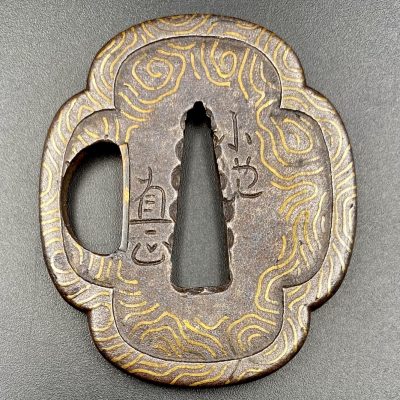
TSU-0421.2022. Varshavsky Collection, SF, CA, USA.
An update from October 20, 2022:
1) One more signed Yoshirō tsuba from MET with the signature is inlaid in brass.
2) An unsigned piece, Yoshirō school, H: 88.3 x 88.7 mm x 4.0 mm.
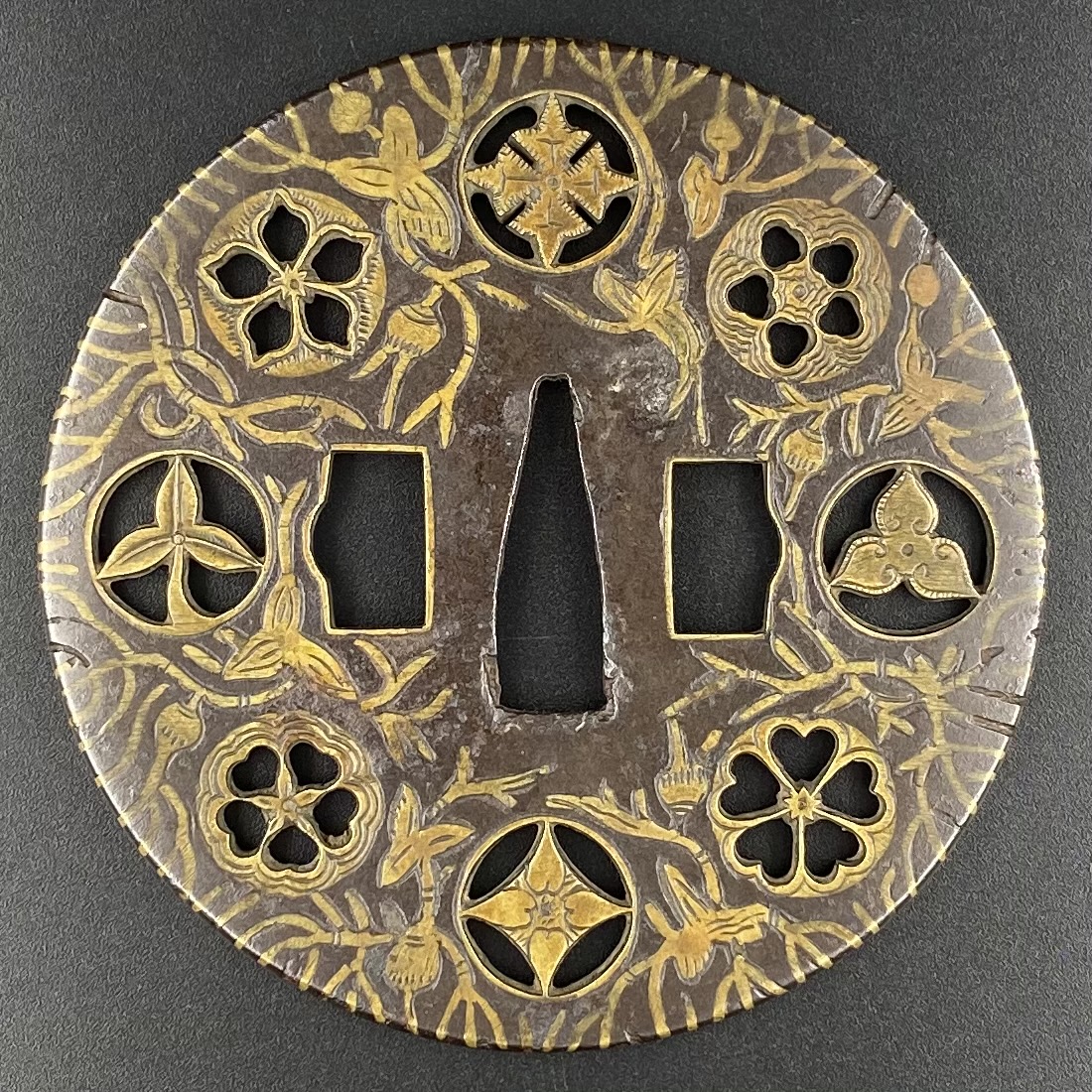
TSU-0417.2021. Varshavsky Collection, SF, CA, USA.
3) Signed tsuba from Dr Kazutaro Torigoye’s collection, 81.7 x 78.8 x 4.3 cm.
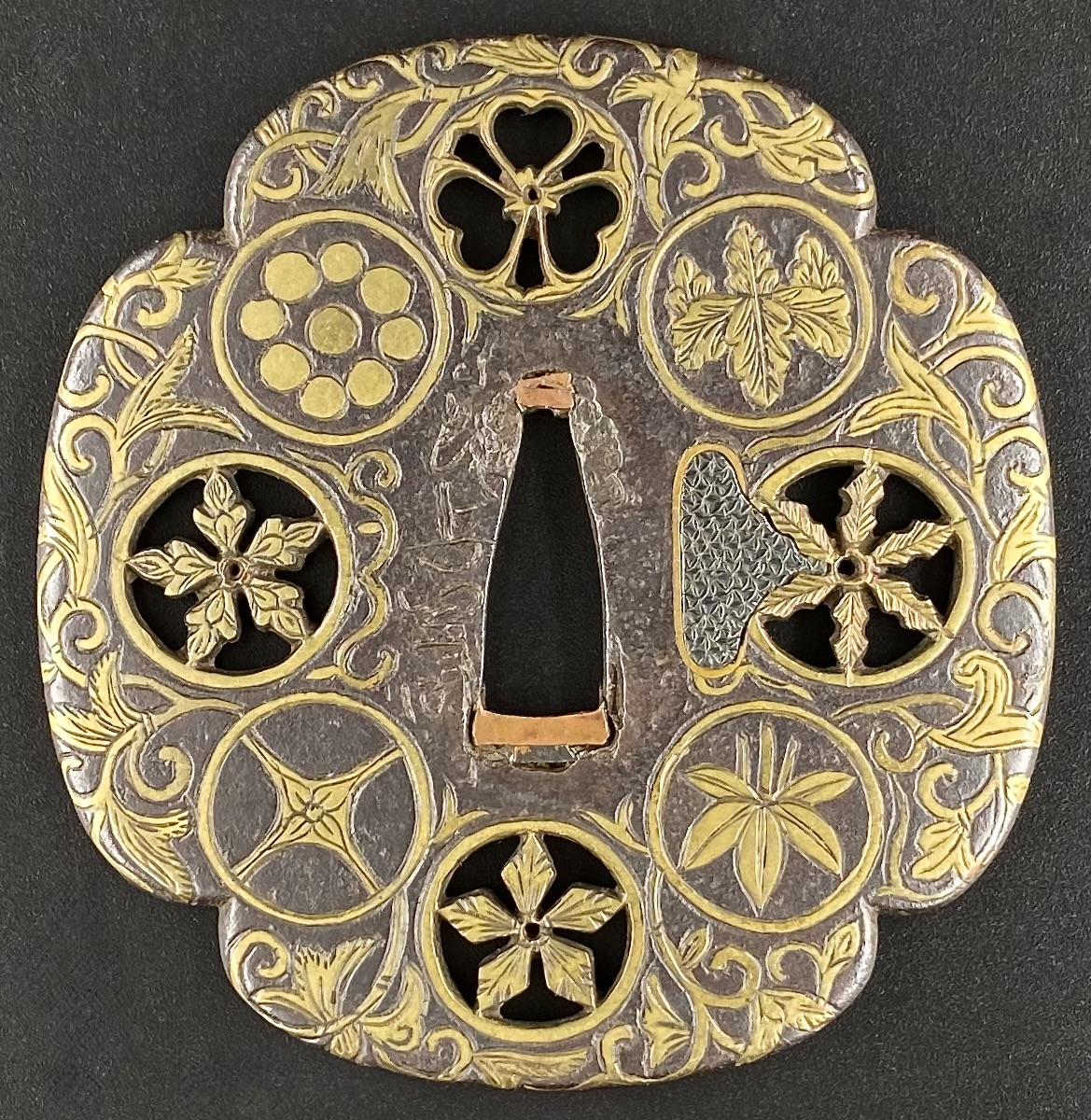
TSU-0429.2022. Varshavsky Collection, SF, CA, USA.
May 18, 2023:
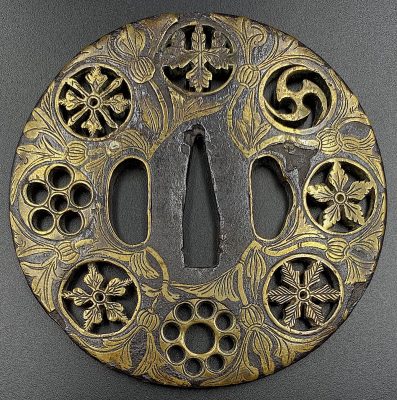
TSU-0431.2023. Varshavsky Collection, SF, CA, USA.
THE END
References
- Japanese Sword Guards. Onin-Heianjo-Yoshiro. Gary D. Murtha. GDM Publications, 2016.
- Tsuba. An aesthetic study. By Kazutaro Torigoye and Robert E. Haynes from the Tsuba Geijutsu-kō of Kazataro Torigoye. Edited and published by Alan L. Harvie for the Nothern California Japanese Sword Club, 1994-1997.
- Fine Japanese tsuba, fittings, woodblock prints, netsuke, inro and books on swords and tsuba. San Francisco, March 1-27, 1983. Catalog #5. Robert E. Haynes, Ltd.
- Okabe-Kakuya. JAPANESE SWORD GUARDS. Museum of Fine Arts, Boston, in cooperation with the department of Chinese and Japanese art, 1908.
- Comte de Tressan: L’évolution de la garde de sabre japonaise de la fin du XVe siècle au commencement du XVIIe (suite). Bulletin de la Société Franco-Japonaise de Paris, juin-septembre 1910, №19-20.
- “Japanese Sword Fittings. A descriptive catalogue of the Collection of G.H. Naunton, Esq., completed and illustrated by Henri L. Joly, 1912.
- Japanese sword-mounts. A descriptive catalogue of the collection of J. C. Hawkshaw, Esq., M.A., of Hollycombe, Liphook. Complied and illustrated by Henri L. Joly. London, 1910. Privately printed for J. C. Hawkshaw, Esq., M.A., to three hundred copies of which this is No.282. By the Tokio printing company, Reading.
- Henri L. Joly and Kumasaku Tomita. Japanese art and handicraft. An illustrated record of the loan exhibition held in aid of the British Red Cross in October – November, 1915. London, Yamanaka & Co, 1916.
- Important tsuba, menuki, bokuto, woodblock prints, koshirae, sword pistol and kana mono. San Francisco, June 1-26, 1983. Catalog #6. Robert E. Haynes, Ltd.
- Masterpiece and highly important tsuba, menuki, and fuchi-kashira from eminent collections in America, England, France, and Japan. San Francisco, May 8-12 and May 21-27, 1984. Catalog #9. Robert E. Haynes, Ltd.
- Japanese sword-fittings and metalwork in the Lundgren Collection. Published by Otsuka Kogeisha Co., Ltd., Tokyo 1992. Produced by Kamakurayama Kikaku.
- The Lundgren Collection of Japanese Swords, Sword Fittings and A Group of Miochin School Metalwork. Christie’s Auction: Tuesday, 18 November 1997, London. Sales “GOTO-5881”. Christie’s, 1997.
- Robert E. Haynes. Study Collection of Japanese Sword Fittings. Nihon Art Publishers, 2010.
- Japanese Works of Art, Part II: Swords and Fittings, Netsuke and Lacquer. Sale LN4670 “SUZUKI”. Sotheby’s, London on November 17, 1994.
- Henri L. Joly and Kumasaku Tomita. Japanese art and handicraft. An illustrated record of the loan exhibition held in aid of the British Red Cross in October – November, 1915. London, Yamanaka & Co, 1916.
- Japanese sword-mounts in the collection of Field Museum by Helen C. Gunsaulus, Assistant Curator of Japanese Ethnology. 61 plates. Berthold Laufer, Curator of Anthropology. Field Museum of Natural History, Publication 216, Anthropological Series, Volume XVI; Chicago, 1923.
- The Iron Tsuba of Japan by Edgar Jepson. The Connoisseur. An Illustrated Magazine For Collectors. Edited by Reginald Grundy. Vol. LXX (September – December, 1924). London.
- Japanese swordfurniture collection of the late general J. C. Pabst which will be sold by auction by Van Stockum’s Antiquariaat (J. Kuipers) at the galleries Prinsegracht 15, The hague, on Tuesday, the June 26th, 1956. Photos and cliché’s: Biegelaar & Jansen – Utrecht. Printing: G. M. Van Gent – Ridderkerk.
- The Peabody Museum collection of Japanese sword guards with selected pieces of sword furniture, by John D. Hamilton. Salem, MA, 1975.
- Highly important Japanese swords and kodogu. San Francisco, November 13-15, 1981. Robert E. Haynes, Ltd.
- Important Japanese kodogu, gaiso and works of art. San Francisco, April 9-11, 1982. Robert E. Haynes, Ltd.
- Fine Japanese tsuba, fittings, woodblock prints, netsuke, inro and books on swords and tsuba. San Francisco, March 1-27, 1983. Catalog #5. Robert E. Haynes, Ltd.
- Masterpiece tsuba and kodogu from the Hans Conried and Alexander G. Mosle collections. Important woodblock prints by Utamaro, Hokusai, Hiroshige, Yoshida and other masters. San Francisco, September 1-25, 1983. Catalog #7. Robert E. Haynes, Ltd.
- Important signed Shoami tsuba, collection of fine menuki, kozuka, and fuchi-kashira, interesting and important 19th and 20th century woodblock prints and books. San Francisco, January 16 to February 12, 1984. Catalog #8. Robert E. Haynes, Ltd.
- Catalog #9. Robert E. Haynes, Ltd. Masterpiece and highly important tsuba, menuki, and fuchi-kashira from eminent collections in America, England, France, and Japan. San Francisco, May 8-12 and May 21-27, 1984.
- Japanese Swords and Sword Fittings from the Collection of Dr. Walter Ames Compton (Part II). Specialists in charge: Sebastian Izzard and Yoshinori Munemura. Christie’s, New York, October 22, 1992.
- Tosogu. Treasure of the samurai. Fine Japanese Sword Fittings from The Muromachi to The Meiji Period, by Graham Gemmell. Sarzi-Amadè Limited, London, 1991. An exhibition held in London from 21st March to 4th April 1991. [Muromachi Period Tsuba by Robin Peverett].
- Japanese Swords and Sword Fittings from the Collection of Dr. Walter Ames Compton (Part I). Specialists in charge: Sebastian Izzard and Yoshinori Munemura. Christie’s, New York, March 31, 1992.
- Japanese Swords and Sword Fittings from the Collection of Dr. Walter Ames Compton (Part III). Specialists in charge: Sebastian Izzard and Yoshinori Munemura. Christie’s, New York, December 17, 1992.
- One hundred masterpieces from the collection of Dr. Walter A. Campton”. Christie, Manson & Woods International, Inc., 1992.
- Tsuba. Text and Photography: Günter Heckmann. Printed in Germany by Offizin Anderson Nexö GmbH, 1995.
- Masterpieces from the Randolph B. Caldwell Collection: Japanese sword fittings. An exhibition held at SYZ Limited, London from 14th to 25th November 1994. Published by SYZ Limited, Oriental and European Works of Art, London, 1994.
- Kokusai Tosogu Kai; 7th International Convention & Exhibition, November 1st, 2011.
- The Henry D. Rosin Collection of Japanese Sword Fittings. An exhibition held at Syz Limited, London from 11th to 25th June 1993; Catalogue by Patrick Syz.// Published by Syz Limited, London, 1993.
- Japanese Sword Fittings from the Alexander G. Moslé Collection; Sebastian Izzard LLC, 2004.
- The Carlo Monzino Collection of Japanese sword fittings and swords. The property of a private trust. Sotheby’s, London, 18 June 1996.
- Kokusai Tosogu Kai; The 2nd International Convention & Exhibition, October 18-23, 2006 at Takashimaya Department Store, Nihonbashi, Tokyo, Japan.
- Japanische Schwertzieraten. Beschreibung einer kunstgeschichtlich geordneten Sammlung, mit Charakteristiken der Künstler und Schulen von Gustav Jacoby. Hierzu siebenunddreissig Tafeln in Heliogravüre. Text. Verlag von Karl W. Hiersemann, Leipzig, 1904.


